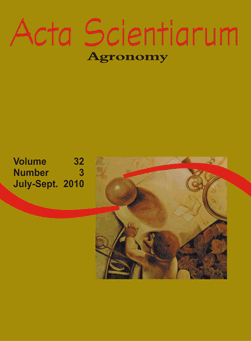<b>Alterações na cutícula de maçãs ‘Fuji’ e ‘Gala’ em função do tratamento térmico e da armazenagem refrigerada</b> - doi: 10.4025/actasciagron.v32i3.4712
Resumo
As doenças de pós-colheita são fatores limitantes para estocagem de produtos colhidos. É crescente o interesse por métodos alternativos para o controle de podridão em pós-colheita. A termoterapia pré-estocagem parece ser um método promissor podendo ser aliado a outros métodos alternativos. O objetivo deste trabalho foi verificar os efeitos do tratamento térmico por aspersão e imersão na cutícula de maçãs (Malus domestica Borkh.) Fuji e Gala após tratamento e período curto de armazenagem. Foram realizados seis tratamentos, com três repetições de três frutos: testemunha, imersão em água quente a 58°C-30 s, 1 e 2 min., aspersão em água quente a 58°C-30 s; imersão em clorofórmio 30 segundos. Foram retiradas amostras para visualização em microscopia eletrônica de varredura na instalação e três semanas de armazenamento a 0°C. Durante a armazenagem, as rachaduras da cutícula aumentam em largura, sendo esta uma característica importante na pós-colheita, pois estas propiciam maior perda de água e podem tornar-se sítios de penetração de patógenos. O calor derrete os cristaloides de cera da cutícula para formar um padrão de recobrimento mais homogêneo na superfície e a oclusão de fraturas, podendo atuar como barreira física para evitar a entrada de patógenos nas maçãs bem como reduzir a perda de massa fresca.Downloads
DECLARAÇÃO DE ORIGINALIDADE E DIREITOS AUTORAIS
Declaro que o presente artigo é original, não tendo sido submetido à publicação em qualquer outro periódico nacional ou internacional, quer seja em parte ou em sua totalidade.
Os direitos autorais pertencem exclusivamente aos autores. Os direitos de licenciamento utilizados pelo periódico é a licença Creative Commons Attribution 4.0 (CC BY 4.0): são permitidos o compartilhamento (cópia e distribuição do material em qualqer meio ou formato) e adaptação (remix, transformação e criação de material a partir do conteúdo assim licenciado para quaisquer fins, inclusive comerciais.
Recomenda-se a leitura desse link para maiores informações sobre o tema: fornecimento de créditos e referências de forma correta, entre outros detalhes cruciais para uso adequado do material licenciado.




















































